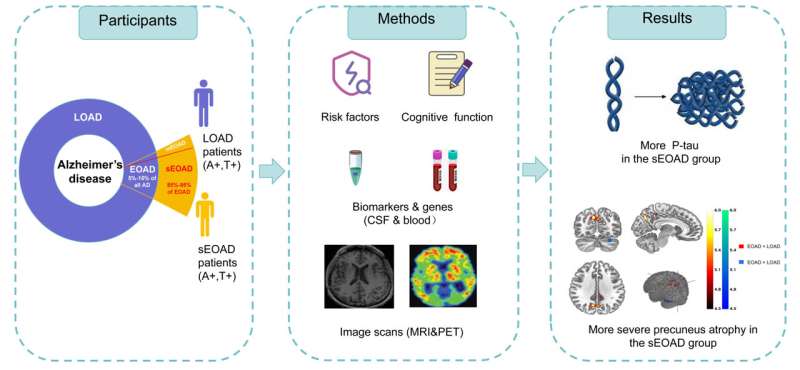This article has been reviewed according to Science X's editorial process and policies. Editors have highlighted the following attributes while ensuring the content's credibility:
fact-checked
trusted source
proofread
Study sheds light on sporadic early-onset Alzheimer's disease, potential target for novel treatment

Alzheimer's disease (AD), the most prevalent neurodegenerative disease globally, poses a significant threat to human health. Most AD patients are diagnosed after the age of 65, categorized as late-onset AD (LOAD). However, about 5%–10% of AD patients show symptoms before the age of 65, exhibiting the same pathological characteristics as AD, classified as early-onset AD (EOAD).
Recently, attention has been drawn to the younger onset age of AD. Previous studies have hinted that EOAD is often associated with familial inheritance and gene mutations, but emerging evidence shows that only a small proportion (10%–15%) of EOAD patients have a consistent genetic pattern.
The majority of EOAD patients are sporadic or show inconsistent genetic patterns, referred to as sporadic EOAD (sEOAD). These patients are often overlooked and misdiagnosed in the early stages of the disease, and the characteristics of this patient population are yet to be fully explored. Globally, there is a lack of cohort studies and related reports focusing on the characteristics of the sEOAD population.
A recent research article titled "High burdens of phosphorylated tau protein and distinct precuneus atrophy in sporadic early-onset Alzheimer's disease" by Professors Shi Jiong and Shen Yong's team from the University of Science and Technology of China has been published. This longitudinal study, which spanned five years, included 110 sEOAD patients, 89 LOAD patients, and 75 age-matched healthy controls. It systematically described the clinical features of the sEOAD population, providing new insights into sEOAD.
The study excluded familial EOAD patients, and all included AD patients who met the diagnostic criteria based on biomarker evidence within the ATN framework. All patients underwent a thorough risk factor analysis, multi-dimensional cognitive function evaluations, multi-modal molecular imaging assessments, and cerebrospinal fluid and peripheral blood biomarker detection.
The results showed that compared to LOAD patients, sEOAD patients did not exhibit specific risk factors but had more severe executive function deficits and bilateral precuneus atrophy. The levels of phosphorylated tau 181 (P-tau181) in the cerebrospinal fluid and plasma of sEOAD patients were also significantly higher compared to the LOAD group.
This study preliminarily explored the multi-dimensional clinical characteristics of the sEOAD population diagnosed based on biomarkers under the ATN framework. It highlighted the importance of tau protein phosphorylation in the onset and progression of sEOAD, contributing to a comprehensive understanding of the etiology, age of onset determinants, and disease progression of AD. This provides valuable insights for potential therapeutic strategies.
The findings are published in the journal Science Bulletin.
More information: Xinyi Lv et al, High burdens of phosphorylated tau protein and distinct precuneus atrophy in sporadic early-onset Alzheimer's disease, Science Bulletin (2023). DOI: 10.1016/j.scib.2023.10.019


















